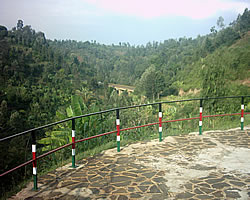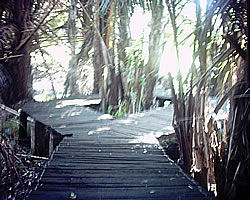|
Find Your Trip
....................................................................................................................................
The Central Highlands
 Meru Meru
3 hours from Nairobi is some of the greenest
landscape in Kenya, not well traversed by tourists both local and
foreign. As such there aren't many tourist attractions, though there
certainly is the potential for more.
The journey
We journey north along Thika Road up until we get
to the turnoff at Makutano town. This is an area that is rife with
subsistence farming, especially maize. Rice is also grown in plenty,
although on a much smaller scale. The local community was fortunate
to have had help setting up irrigation schemes, so now they tend to
their individual paddy fields which fill these plains. This is a
good place to buy rice in bulk because almost all shops specialize
in selling it.
Other towns along the way include Wanguru and
Kimbimbi, small townships where donkey drawn handcarts are still
popularly used as a mode of transportation. Donkeys more often than
not, even have the right of way!
Embu
The countryside becomes greener as we drive further
on and then two hours after our departure from Nairobi we arrive in
Embu town, the provincial headquarters of the Eastern Province .
This is a neat, uncongested town that is a convenient stopover for
travellers. The Izaak Walton inn is a decent place where you can
take a short break or if you want to spend the night as
accommodation is also available. We arrive when most of the guests
are in for a seminar, so it's just us enjoying a beverage in the
manicured gardens and lawns.
Meru
As evening sets in, we embark along the Nairobi –
Isiolo road, stopping only to view the Karowe hill just before
Runyenjes town. Some more fascinating landscapes unfold before our
eyes, and we cross quite a few bridges like this one over the River
Thuchi. There is even a platform built for travelers to enjoy the
view. The Nairobi-Meru-Isiolo road is actually quite smooth with no
murram patches. It weaves in and out among the many hills, and one
and half hours from Embu we arrive in Meru town, a business,
agricultural and educational center for the northeast of Kenya , and
a good transit point to Samburu and the north. One hour's drive from
here is our final destination- Maua town. Lodging within the town is
affordable, you can get decent accommodation for as low as 600/=,
although as always, it's advisable to book in advance. Evenings are
quite cold, especially in January, July and December so plan your
trips with this in mind.
The days though, we realize, are much warmer as we
leave the Nyambene lodge for a look around the town. Overlooking
Maua are the prominent Nyambene hills, partially covered in tea
plantations.

Meru National Park
Two paths diverge - path over the river next to
KWS Bwatherongi bandas
Among the activities you can engage in within the
Meru area is a visit to the Meru National Park . Turn off the main
road just before Maua and drive for a while on this rough murram
road.
Back to our reason for being here though and f you
would rather stay nearer the park there are KWS bandas available at
amazingly affordable prices that are charged per banda not per head.
Well-built and furnished, the bandas host a spacious kitchen and
outside cooking areas where you may do your own cooking. Individuals
and families should be comfortable here, and for larger groups there
are dorm like rooms and a dining area.
Take a short nature walk on this foot bridge that
has been built over the underground source of the river Murera, its
clear waters home to small fish.
• Meru National park is managed by the Kenya
Wildlife Service
• All the Big Five can be found here
• It is one of the best in which to locate
cheetah and leopard.
• Is one of Kenya 's lesser known and
infrequently visited reserves.
• Some of the animals are only found north of
the equator
• This is where George and Joy Adamson
released several hand-reared animals
Time now for the main activity within the park- a
game drive. The roads definitely require a four-wheel drive vehicle,
especially during the rainy season. We mostly see herbivores like
the common zebra, Grants gazelle, Defassa waterbuck, reticulated
giraffe, Coke's hartebeest, elephant and buffalos- as meanlooking as
ever. The park is also quite rich in birdlife like the sandgrouse,
guinea fowls and crested eagle. The only carnivore we come across is
this black caracal, a rarely seen member of the cat family.
Currently there are two main lodges to stay at in
this park. One is the Leopard Rock Lodge. Which is unfenced for that
ultimate interaction with wild animals that may come right up to the
cottages. Of course you are advised not to reach out and touch them,
which is perfectly fine! As they wallow outside you can enjoy the
comforts of the cottages, which are extremely spacious. Some are
built with an adjoining door between two so that families can
interact.
We leave in search of the second lodge and pass
some vultures circling above what must be a freshly-killed animal.
Thirteen rivers dissect the park and we cross a number of them,
eventually coming upon the sight of Mughwango hill, another landmark
that once again features in the story of Elsa the lioness who was
brought up by the late George and Joy Adamson. It seems that Elsa's
legacy is widespread throughout Kenya . This hill was George's
original camp, and now it is home to a lodge called Elsa's Kopje-
kopje being a word that means ‘small hill'.
Elsa's Kopje is pure luxury in the wild, and blends
in so well with the natural surroundings that we came upon it by
surprise. From its rock pool and lounge areas enjoy the view of the
park spread out below with its doum palms and lush vegetation. A
rope bridge separates the public areas from the cottages. Nine stone
and thatch guest cottages which engulf you in their privacy and
style. Honeymooners would love it here! And each cottage is attended
to by a butler who caters to your every whim.
The two lodges that we have featured offer
recreational activities at an extra fee, so when booking, make sure
you get all the details beforehand.
As we leave the park we encounter this lone
elephant trying to sniff us out, and further on we see an animal
that has eluded us for a while- a rhino. A rhino sanctuary has been
sealed off with an electric fence to allow them to grow in number.
And what's a more beautiful way to end the day in Meru than with a
magnificent sunset over the Nyambene hills.
Miraa
 Every Kenyan region has a trademark
to it, be it in the natural environment or in lifestyles. We are in
Meru and can not ignore the huge miraa trade that exists here. It's
our final morning and on the way out of Maua we visit a miraa
marketplace. Miraa, otherwise known as ‘khat', is a plant that grows
up to a certain height at which its top leaves are pruned, leaving
the stalks bear so that buds grow out of them. It is these that are
harvested. The traders are busy at work taking this plant through
various processes. First of all the miraa is brought in big bundles
from the farms. These are then bought either in the same quantity or
smaller, after which the green leaves are removed. Every Kenyan region has a trademark
to it, be it in the natural environment or in lifestyles. We are in
Meru and can not ignore the huge miraa trade that exists here. It's
our final morning and on the way out of Maua we visit a miraa
marketplace. Miraa, otherwise known as ‘khat', is a plant that grows
up to a certain height at which its top leaves are pruned, leaving
the stalks bear so that buds grow out of them. It is these that are
harvested. The traders are busy at work taking this plant through
various processes. First of all the miraa is brought in big bundles
from the farms. These are then bought either in the same quantity or
smaller, after which the green leaves are removed.
I am made to understand that the reddish stalks and
leaves are the sweetest, so these are then tied up into smaller
bundles that sell at 70 shillings. These smaller bundles are then
bound in banana leaves that have to be fresh so as to help retain
moisture and freshness of the miraa. Once done they are ready to be
ferried across the countryside to airports in Nairobi for export to
African and European countries. From the speed at which the trucks
are driven it must be a booming trade indeed.
We follow at an easier pace as we leave this hilly
green country. So if you are in search of peace and quiet with some
nature viewing and perhaps an experience in rural town life, then a
visit to Meru is certainly for you.
Accommodation rates and
images
Related links:
| 


